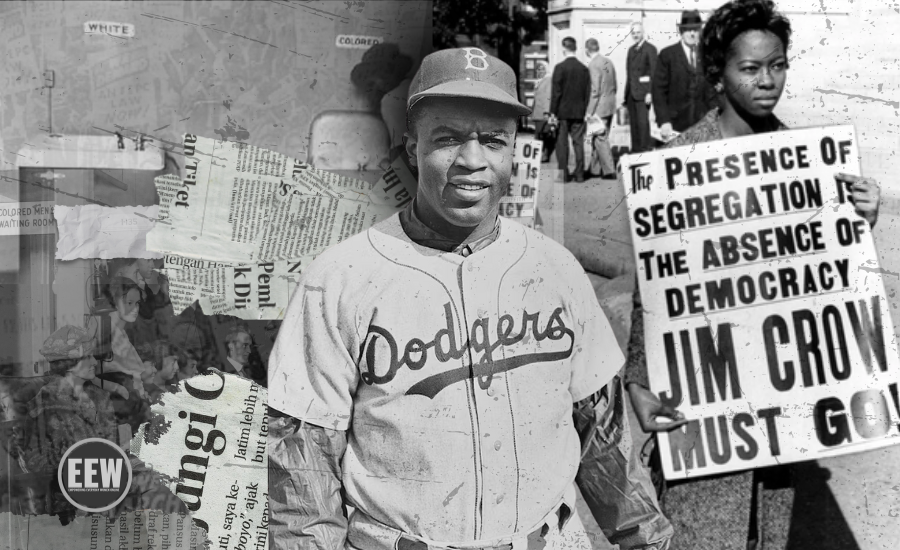Separating Fact from Fiction: Unpacking Jackie Robinson and Federal Contract Changes
EEW Magazine separates fact from fear, explaining the brief removal of Jackie Robinson’s DoD webpage and the end of a segregated facilities clause in federal contracts. Get the real story behind the headlines—no alarm, just truth.
Written By By Angela Denise Carter for EEW Magazine Online
A historical collage captures the fight against segregation, featuring Jackie Robinson in his Dodgers uniform alongside civil rights protest signs. This image reflects the past struggles that inform today’s debates, as explored in Angela Denise Carter’s article on recent policy changes. (Photo: EEW Magazine Online)
Earlier this week, I found myself in a modest conference room at a local community center—the kind with humming fluorescent lights and creaky folding chairs. The scent of strong coffee mingled with the tang of lemon polish on the long table.
I was attending a training session with about a dozen colleagues—mostly Black women like me, all engaged in faith-based outreach. Our presenter, Dr. Ellis (a pseudonym), an African American community activist, stood at the front, her voice steady as she presented sobering statistics: disparities in healthcare, education, and employment that continue to affect our community. I diligently took notes, nodding in agreement—until she made a startling statement.
“They’re trying to erase Jackie Robinson and take us back to Jim Crow days,” Dr. Ellis declared, her tone slicing through the room's quiet murmurs.
Heads snapped up. A sister to my left murmured, “Mm-hmm, that’s right.” Another across the table shouted, “Amen,” while words like “racist” and “fascist” were muttered, aimed at the Trump administration. The room buzzed with agreement, a mix of anger and fear ripping through like a sudden wind. I felt my stomach tighten—not because I doubted the challenges we face; I witness them daily—but because I've learned to look beyond sensational headlines and social media posts to uncover the truth.
So, what's really happening? Let's sift through the fiction and fear to uncover the facts.
Jackie Robinson’s Webpage
Jackie Robinson, the baseball legend who broke Major League Baseball's color barrier in 1947, also served as a second lieutenant in the U.S. Army during World War II. He stood up to racism—such as refusing to move to the back of a segregated military bus, which led to a court-martial from which he was later acquitted.
For years, the Department of Defense (DoD) maintained a webpage about his service, titled “Sports Heroes Who Served: Baseball Great Jackie Robinson Was a World War Two Soldier.”
On March 19, 2025, it was reported that this article about Robinson's military career was briefly removed from the DoD website before being restored later that day. The removal was part of a DoD "digital content refresh" aimed at eliminating content tied to Diversity, Equity, and Inclusion (DEI) programs, following a Trump administration directive to reduce such initiatives across federal agencies. Robinson's page was inadvertently caught in this sweep, even though it was more historical in nature than DEI-focused.
After public outcry, including from Representative Yvette Clarke of New York's 9th Congressional District, who accused the administration of erasing Black history, the DoD restored the page within a day, referring to the removal as a "mistaken removal." They stated that the goal wasn't to erase Robinson's legacy but to streamline content, and some historical pages were mistakenly affected.
The incident highlights ongoing tensions over the administration's push to remove diversity references from federal platforms. Robinson's story is now back online, and no laws or policies regarding his recognition have changed. It was a website error in a broader cleanup, not a step toward segregation.
Federal Contracts and the Segregated Facilities Ban
There has also been discussion about a February 2025 memo from the U.S. General Services Administration (GSA), which was widely noticed this month. This memo removes a clause from federal contracts that banned "segregated facilities"—such as waiting rooms or drinking fountains—for companies performing government work. This clause originated from a 1965 executive order by President Lyndon Johnson to ensure contractors didn't discriminate.
The removal is part of the same initiative to dismantle DEI policies. An executive order in January 2025 revoked Johnson's 1965 order and others, arguing they promoted "illegal discrimination" over merit. The GSA followed through, stating the clause isn't necessary since laws like the Civil Rights Act of 1964 still prohibit segregation and discrimination for all businesses, including contractors.
It's important to note that this doesn't make segregation legal again. Contractors are still bound by existing laws—no one is reinstating "whites only" signs. It's a modification to contract language, not a rollback of civil rights protections. Critics view it as a symbolic retreat; supporters see it as streamlining. Either way, it's not a return to Jim Crow.
Facts Over Fearmongering
Back in that training room, I observed my colleagues nodding along with Dr. Ellis, their concerns genuine and rooted in our shared history. I understand—names like Jackie Robinson and terms like "segregation" resonate deeply with us. But when the presenter claimed they're "erasing" him and reverting to Jim Crow, she relied on fear rather than facts.
Our community deserves facts, not fearmongering. When we over-sensationalize, we risk becoming the boy who cried wolf—our real concerns drowned out by a chorus of alarm. So I went looking for what’s actually happening with Jackie Robinson’s story and this talk of “Jim Crow” creeping back.
These changes—a webpage down for a day, a contract clause removed—are significant and warrant our attention. Yet, they're not the full-scale assault some suggest.
Look, our community faces real issues that require clear-headed and intelligent solutions, not distractions from exaggerated alarms. Let’s remain grounded. Investigate the sources. Pray for discernment. We have too much work to do—uplifting each other and forging ahead—to get lost in the hype.




